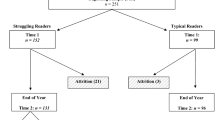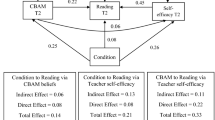Abstract
In the USA, students with emotional and behavioral disorders (EBD) are among the most vulnerable to have reading difficulties, experience general academic failure, and drop out of school. Students with EBD who receive schooling in residential treatment centers are at even greater risk for academic difficulties. To date, very little research has examined the impact of reading interventions for students educated within a residential treatment center. The primary goal of this two-part study was to evaluate the effects of a reading intervention with four students with EBD who were attending a residential treatment center. Each student received an evidence-based reading fluency intervention to increase their reading skills, and data collected in a multiple baseline design across participants demonstrated that each student responded favorably to the intervention. Standardized reading assessments, administered pre-post, supported evidence of intervention effectiveness. Implications for applied research and practice are discussed, including the implications for using participants’ feedback to modify and enhance intervention procedures.


Similar content being viewed by others
References
AIMSweb (2016). AIMS Web home page. Retrieved from http://aimsweb.com/
Allen-DeBoer, R. A., Malmgren, K. W., & Glass, M. (2006). Reading instruction for youth with emotional and behavioral disorders in a juvenile correctional facility. Behavioral Disorders, 32, 18–28.
Allinder, R. M., Dunse, L., Brunken, C. D., & Obermiller-Krolikowski, H. J. (2001). Improving fluency in at-risk readers and students with learning disabilities. Remedial and Special Education, 22, 48–54.
Al-Otaiba, S., & Rivera, M. O. (2006). Individualized guided oral reading fluency instruction for students with emotional and behavioral disorders. Intervention in School and Clinic, 41, 144–149. https://doi.org/10.1177/10534512060410030301.
Archer, A. L., Gleason, M. M., & Vachon, V. L. (2003). Decoding and fluency: Foundation skills for struggling older readers. Learning Disabilities Quarterly, 26, 89–101.
Becker, S. P., Paternite, C. E., & Evans, S. E. (2014). Special educators’ conceptualizations of emotional disturbance and educational placement decision making for middle and high school students. School Mental Health, 6, 163–174. https://doi.org/10.1007/s12310-014-9119-7.
Begeny, J. C. (2011). Effects of the Helping Early Literacy with Practice Strategies (HELPS) reading fluency program when implemented at different frequencies. School Psychology Review, 40, 149–157.
Begeny, J. C., Mitchell, R. C., Whitehouse, M. H., Harris, C. F., & Stage, S. A. (2011). Effects of the HELPS reading fluency program when implemented by classroom teachers with low performing second-grade students. Learning Disabilities Research & Practice, 26, 122–133.
Blankenship, T. L., Ayres, K. M., & Langone, J. (2005). Effects of computer-based cognitive mapping on reading comprehension for students with emotional behavior disorders. Journal of Special Education Technology, 20, 15–23.
Bradley, R., Doolittle, J., & Bartolotta, R. J. (2008). Building on the data and adding to the discussion: The experiences and outcomes of students with emotional disturbance. Journal of Behavioral Education, 17, 4–23. https://doi.org/10.1007/s10864-007-9058-6.
Chen, C., & Ma, H. (2007). Effects of treatment on disruptive behaviors: A quantitative synthesis of single-subject researches using the PEM approach. The Behavior Analyst Today, 8, 380–397 https://doi.org/10.1037/h0100629.
Christ, T., & Silberglitt, B. (2007). Estimates of the standard error of measurement for curriculum based measures of oral reading fluency. School Psychology Review, 36, 130–146.
Cohen, M. A., Piquero, A. R., & Jennings, W. G. (2010). Estimating the costs of bad outcomes for at-risk youth and the benefits of early childhood interventions to reduce them. Criminal Justice Policy Review, 21, 391–434.
Darney, D., Reinke, W. M., Herman, K. C., Stormont, M., & Ialongo, N. S. (2013). Children with co-occurring academic and behavior problems in first grade: Distal outcomes in twelfth grade. Journal of School Psychology, 51, 117–128.
Espin, C., & Foegen, A. (1996). Validity of three general outcome measures for predicting secondary students’ performance on content-area tasks. Exceptional Children, 62, 497–514.
Florida Department of Education. (2005). Primary and secondary diagnostic instruments. Retrieved from http://justreadflorida.com/educators/PrimSecDiagChart.asp?style=normal
Greenbaum, P. E. (1996). National Adolescent and Child Treatment Study (NACTS): Outcomes for children with serious emotional and behavioral disturbances. Journal of Emotional and Behavioral Disorders, 4, 130–146.
Individuals with Disabilities Education Act of 1997, 20 U.S.C. 1413(e)(3) and (4) §300.224 (2004).
Kame'enui, E., Francis, D., Fuchs, L., Roland, H., Good, I., O’Connor, R., Simmons, D. C., et al., (2002). An analysis of reading assessment instruments for k-3 (report). Eugene: Institute for the Development of Educational Achievement, College of Education, University of Oregon.
Kamil, M. L., Borman, G. D., Dole, J., Kral, C. C., Salinger, T., & Torgesen, J. (2008). Improving adolescent literacy: Effective classroom and intervention practices. IES Practice Guide. NCEE 2008-4027. National Center for Education Evaluation and Regional Assistance.
Klubnik, C., & Ardoin, S. P. (2010). Examining immediate and maintenance effects of a reading intervention package on generalization materials: Individual verses group implementation. Journal of Behavioral Education, 19, 7–29. https://doi.org/10.1007/s10864-009-9096-3.
Lane, K. L., Wehby, J. H., Little, M. A., & Cooley, C. A. (2005). Academic, social, and behavioral profiles of students with emotional disorders educated in self-contained classrooms and self-contained schools: Part one-are they more alike than different. Behavioral Disorders, 30, 349–361.
Levy, S., & Chard, D. J. (2001). Research on reading instruction for students with emotional and behavioral disorders. International Journal of Disability, Development and Education, 48, 429–444. https://doi.org/10.1080/10349120120094301.
Lingo, A. S., Slaton, D. B., & Jolivette, K. (2006). Effects of corrective reading on the reading abilities and classroom behaviors of middle school students with reading deficits and challenging behavior. Behavioral Disorders, 31, 265–283.
Ma, H. H. (2006). An alternative method for quantitative synthesis of single-subject research: Percentage of data points exceeding the median. Behavior Modification, 30, 598–617.
Manolov, R., Solanas, A., & Leiva, D. (2010). Comparing “visual” effect size indices for single-case designs. Methodology, 6, 49–58.
McDaniel, S. C., Houchins, D. E., & Terry, N. P. (2011). Corrective reading as a supplementary curriculum for students with emotional and behavioral disorders. Journal of Emotional and Behavioral Disorders, 21, 240–249.
McGrew, K. S., & Woodcock, R. W. (2001). Technical manual. Woodcock-Johnson III. Itasca: Riverside Publishing.
National Center on Response to Intervention (2011). Progress monitoring tools. Retrieved from http://www.rti4success.org/progressMonitoringTools/
National Center on Student Progress Monitoring (2007). Review of progress monitoring tools. Retrieved July 1, 2008, from http://www.studentprogress.org/chart/chart.asp
National Reading Panel (2000). Report of the national reading panel: Teaching children to read: An evidence-based assessment of the scientific research literature on reading and its implications for reading instruction, Reports of the subgroups. Retrieved from https://www.nichd.nih.gov/publications/pubs/nrp/Documents/report.pdf
Neddenriep, C., Hale, A., Skinner, C., Hawkins, R., & Winn, B. (2007). A preliminary investigation of the concurrent validity of reading comprehension rate: A direct, dynamic measure of reading comprehension. Psychology in the Schools, 44, 373–388.
Parker, R. I., Hagan-Burke, S., & Vannest, K. (2007). Percentage of all non-overlapping data (PAND): An alternative to PND. Journal of Special Education, 40, 194–204.
Pearson, N. C. S. (2012). AIMSweb technical manual. Pearson: Bloomington.
Quinn, M. M., Rutherford, R. B., Leone, P. E., Osher, D. M., & Poirier, J. M. (2005). Youth with disabilities in juvenile corrections: A national survey. Exceptional Children, 71, 339–345.
Reschly, A. (2010). Reading and school completion: Critical connections and Matthew effects. Reading & Writing Quarterly, 26, 67–90. https://doi.org/10.1080/10573560903397023.
Ross, S. G., & Begeny, J. C. (2011). Improving Latino, English language learners’ reading fluency: The effects of small-group and one-on-one intervention. Psychology in the Schools, 48, 604–618. https://doi.org/10.1002/pits.20575.
Scruggs, T. E., Mastropieri, M. A., & Casto, G. (1987). The quantitative synthesis of single subject research: Methodology and validation. Remedial and Special Education, 8, 24–33.
Shinn, J., Deno, S. L., & Espin, C. (2000). Technical adequacy of the maze task for curriculum-based measurement of reading growth. Journal of Special Education, 34, 164–172.
Skinner, C., Cooper, L., & Cole, C. L. (1997). The effects of oral presentation previewing rates on reading performance. Journal of Applied Behavior Analysis, 30, 331–333. https://doi.org/10.1901/jaba.1997.30-331.
Sutherland, K. S., & Snyder, A. (2007). Effects of reciprocal peer tutoring and self-graphing on reading fluency and classroom behavior of middle school students with emotional or behavioral disorders. Journal of Emotional and Behavioral Disorders, 15, 103–118.
Torgesen, J. K., Wagner, R. K., & Rashotte, C. A. (1999). Test of word reading efficiency. Austin: PRO-ED Publishing, Inc..
Torgesen, J. K., Alexander, A. W., Wagner, R. K., Rashotte, C. A., Voeller, K. K., & Conway, T. (2001). Intensive remedial instruction for children with severe reading disabilities: Immediate and long-term outcomes from two instructional approaches. Journal of Learning Disabilities, 34, 33–58.
Torgesen, J., Schirm, A., Castner, L., Vartivarian, S., Mansfield, W., Myers, D., … & Haan, C. (2007). National Assessment of Title I. Final Report. Vol II: Closing the reading gap—findings from a randomized trial of four reading interventions for striving readers. NCEE 2008-4013. National Center for Education Evaluation and Regional Assistance.
Trout, A. L., Epstein, M. H., Mickelson, W. T., Nelson, J. R., & Lewis, L. M. (2003). Effects of a reading intervention for kindergarten students at risk for emotional disturbance and reading deficits. Behavioral Disorders, 28, 313–326.
Valleley, R. J., & Shriver, M. D. (2003). An examination of the effects of repeated readings with secondary students. Journal of Behavioral Education, 12, 55–76.
Vaughn, S., & Fletcher, J. M. (2012). Response to intervention with secondary school students with reading difficulties. Journal of Learning Disabilities, 45, 244–256.
Wagner, M., Marder, C., Blackorby, J., Cameto, R., Newman, L., Levine, P., & Davies-Mercier, E. (2003). The Achievements of youth with disabilities during secondary school. A report from the national longitudinal transition study-2 (NLTS-2). Retrieved from http://www.nlts2.org/reports/2003_11/nlts2_report_2003_11_complete.pdf
Wagner, M., Newman, L., Cameto, R., & Levine, P. (2006). The academic achievement and functional performance of youth with disabilities. A report of findings from the national longitudinal transition study-2 (NLTS-2). Retrieved from www.nlts2.org/reports/2006_07/nlts2_report_2006_07_complete.pdf
Wagner, M. M., Newman, L. A., & Javitz, H. S. (2014). The influence of family socioeconomic status on the post-high school outcomes of youth with disabilities. Career Development and Transition for Exceptional Individuals, 37, 5–17.
Wanzek, J., Vaughn, S., Roberts, G., & Fletcher, J. M. (2011). Efficacy of a reading intervention for middle school students with learning disabilities. Exceptional Children, 78, 73–87.
Wiederholt, J. L., & Bryant, B. R. (2001). Gray oral reading test-IV. Austin: Pro-Ed.
Author information
Authors and Affiliations
Corresponding author
Ethics declarations
We attest to the following:
• Animals were not used in this research.
• All procedures involving human participants were in accordance with the ethical standards of the NC State University Institutional Review Board and with the 1964 Helsinki declaration and its later amendments or comparable ethical standards. Also, informed consent was obtained from all individual participants included in the study.
Conflict of Interest
On behalf of all authors, the corresponding author states that there is no conflict of interest.
Rights and permissions
About this article
Cite this article
Devaney, A.A., Begeny, J.C., Haskett, M.E. et al. Effects of a Reading Fluency Intervention on Middle School Students Attending a Residential Treatment Center for Youth with Emotional and Behavioral Disorders. Contemp School Psychol 23, 367–378 (2019). https://doi.org/10.1007/s40688-018-0184-z
Published:
Issue Date:
DOI: https://doi.org/10.1007/s40688-018-0184-z




